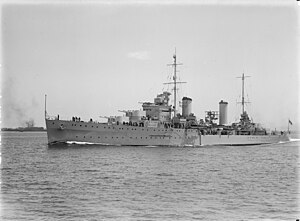 HMAS Sydney in 1936
| |
| History | |
|---|---|
| Name | Sydney |
| Namesake | Sydney, Australia |
| Builder | Swan Hunter & Wigham Richardson, Wallsend-on-Tyne, England |
| Laid down | 8 July 1933 |
| Launched | 22 September 1934 |
| Christened | HMS Phaeton |
| Commissioned | 24 September 1935 |
| Identification | Pennant number: I48/D48 |
| Motto | "I Take But I Surrender" |
| Nickname(s) | |
| Honours and awards |
|
| Fate | Sunk in battle with all hands, 19 November 1941 |
| Notes | Wreck rediscovered in 2008 |
| General characteristics (as built) | |
| Class and type | Modified Leander-class light cruiser |
| Displacement |
|
| Length |
|
| Beam | 56 ft 8.5 in (17.285 m) |
| Draught |
|
| Installed power | 72,000 shaft horsepower (54,000 kW) |
| Propulsion | 4 Admiralty 3-drum boilers, Parsons geared turbines, 4 shafts |
| Speed | 32.5 knots (60.2 km/h; 37.4 mph) |
| Range | 7,000 nautical miles (13,000 km; 8,100 mi) at 16 knots (30 km/h; 18 mph) |
| Complement |
|
| Sensors and processing systems | Type 125 |
| Armament |
|
| Armour |
|
| Aircraft carried | 1 × Supermarine Walrus |
| Aviation facilities | 1 × revolving catapult amidships |
HMAS Sydney, named for the Australian city of Sydney, was one of three modified Leander-class light cruisers operated by the Royal Australian Navy (RAN). Ordered for the Royal Navy as HMS Phaeton, the cruiser was purchased by the Australian government and renamed prior to her 1934 launch.
During the early part of her operational history, Sydney helped enforce sanctions during the Abyssinian Crisis, and at the start of World War II was assigned to convoy escort and patrol duties in Australian waters. In May 1940, Sydney joined the British Mediterranean Fleet for an eight-month deployment, during which she sank two Italian warships, participated in multiple shore bombardments, and provided support to the Malta Convoys, while receiving minimal damage and no casualties. On her return to Australia in February 1941, Sydney resumed convoy escort and patrol duties in home waters.
On 19 November 1941, Sydney was involved in a mutually destructive engagement with the German auxiliary cruiser Kormoran, and was lost with all hands (645 aboard). The wrecks of both ships were lost until 2008; Sydney was found on 17 March, five days after her adversary. Sydney's defeat is commonly attributed to the proximity of the two ships during the engagement, and Kormoran's advantages of surprise and rapid, accurate fire. However, the cruiser's loss with all hands compared to the survival of most of the Germans has resulted in conspiracy theories alleging that the German commander used illegal ruses to lure Sydney into range, that a Japanese submarine was involved, and that the true events of the battle are concealed behind a wide-ranging cover-up, despite the lack of evidence for these allegations.
- ^ Winter 1984, p. 18.
- ^ Mearns 2009, p. 188.